Supply Chain Management: Automation Impact, Risks, and Benefits
VerifiedAdded on 2023/06/04
|9
|1577
|444
Report
AI Summary
This report provides a comprehensive overview of Supply Chain Management (SCM), examining its evolution, terminology, and interdisciplinary nature. It delves into the advantages and limitations of SCM systems, particularly focusing on the role of automation. The report highlights the benefits of automation, such as reduced inventory levels and logistics costs, while also acknowledging the limitations and ethical issues that arise. The report also discusses the impact of automation on the workforce, including potential unemployment risks. It explores the functionality of SCM systems, including demand planning, supplier management, and warehouse operations. The report concludes by emphasizing the importance of ethical considerations and the potential for increased profits through the implementation of SCM systems. It also references the author's research on automation's impact on warehouses and the benefits of human labor versus robotics, and the research is based on New Zealand's perspective.
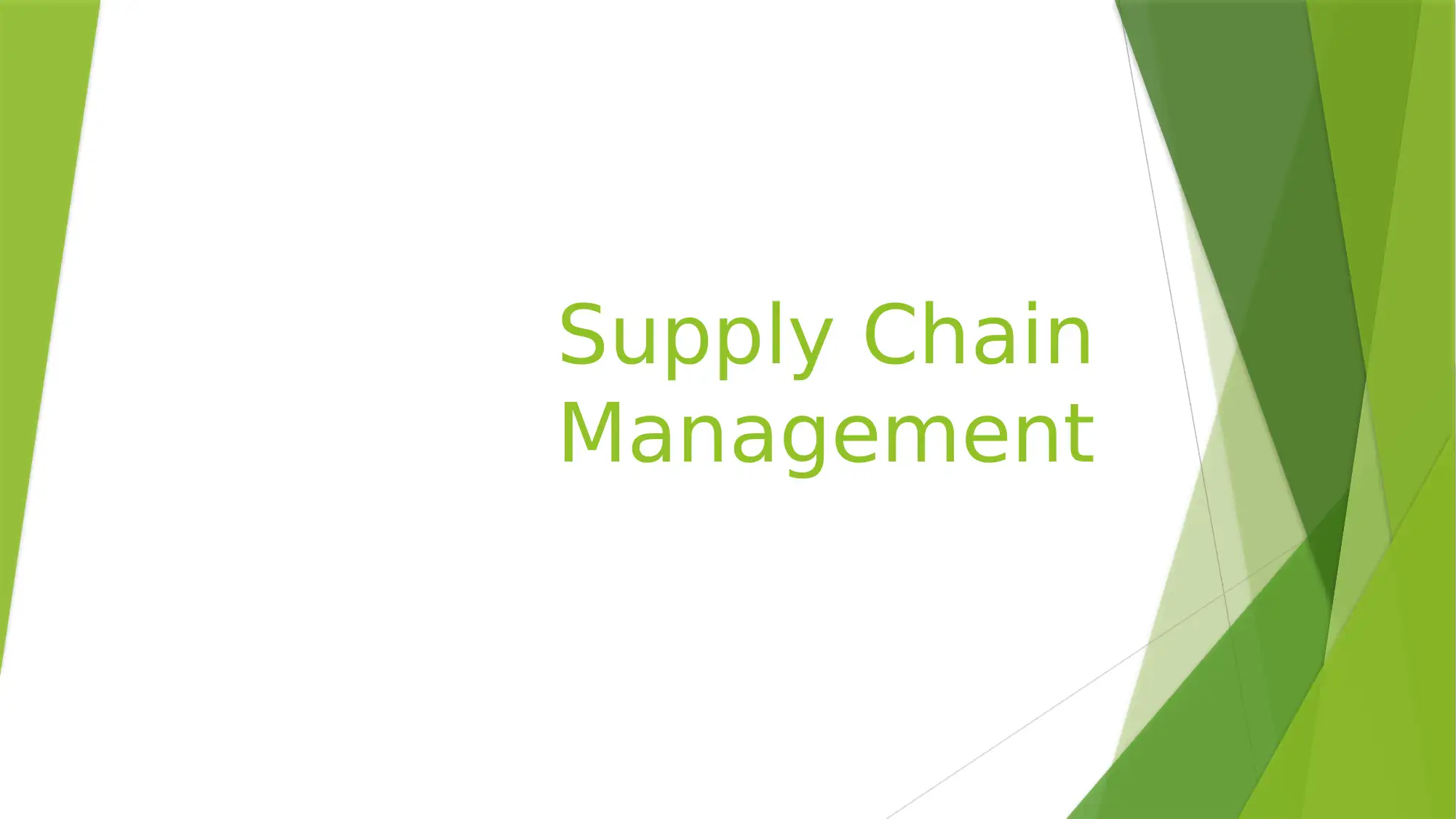
Supply Chain
Management
Management
Paraphrase This Document
Need a fresh take? Get an instant paraphrase of this document with our AI Paraphraser
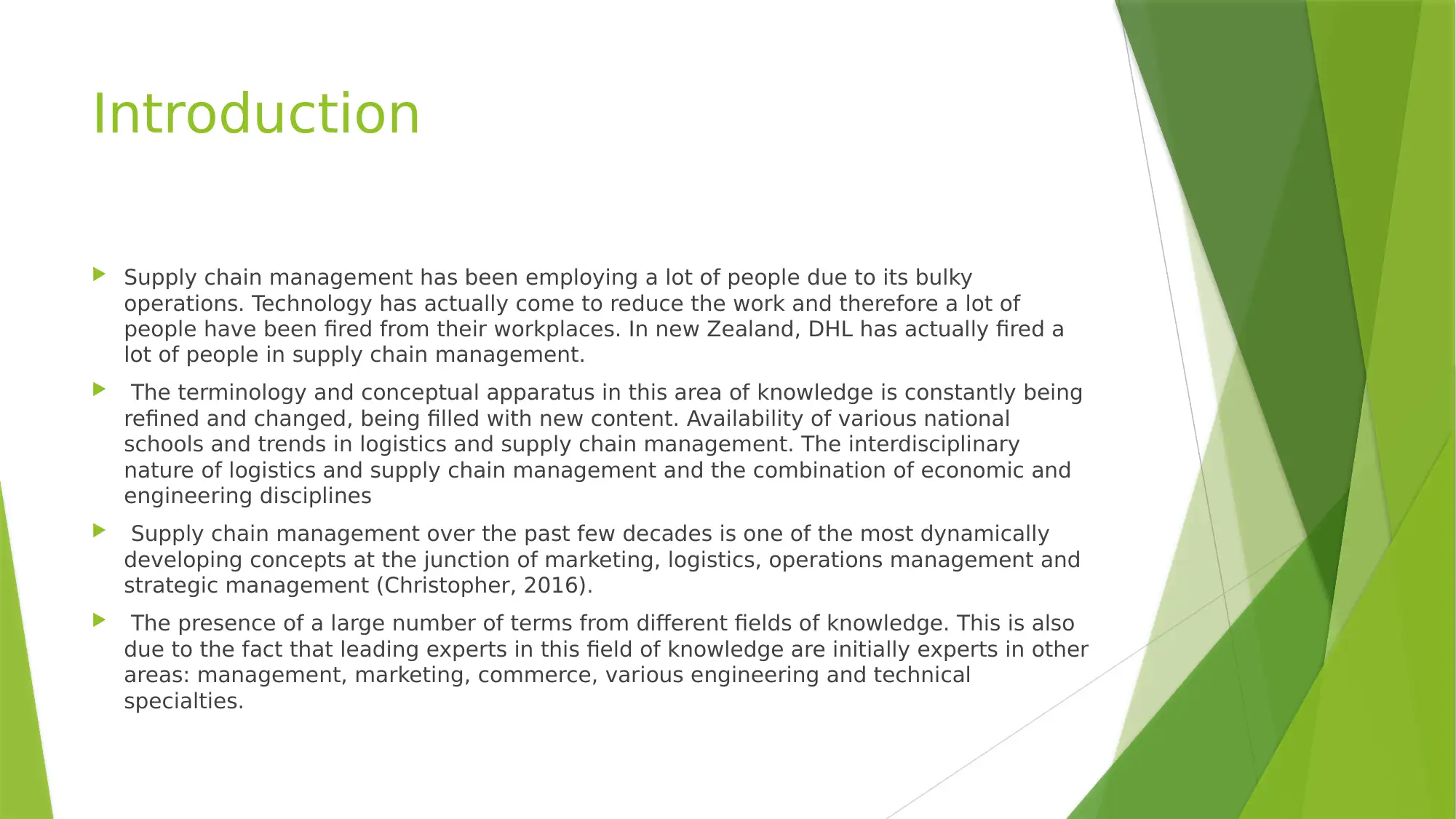
Introduction
Supply chain management has been employing a lot of people due to its bulky
operations. Technology has actually come to reduce the work and therefore a lot of
people have been fired from their workplaces. In new Zealand, DHL has actually fired a
lot of people in supply chain management.
The terminology and conceptual apparatus in this area of knowledge is constantly being
refined and changed, being filled with new content. Availability of various national
schools and trends in logistics and supply chain management. The interdisciplinary
nature of logistics and supply chain management and the combination of economic and
engineering disciplines
Supply chain management over the past few decades is one of the most dynamically
developing concepts at the junction of marketing, logistics, operations management and
strategic management (Christopher, 2016).
The presence of a large number of terms from different fields of knowledge. This is also
due to the fact that leading experts in this field of knowledge are initially experts in other
areas: management, marketing, commerce, various engineering and technical
specialties.
Supply chain management has been employing a lot of people due to its bulky
operations. Technology has actually come to reduce the work and therefore a lot of
people have been fired from their workplaces. In new Zealand, DHL has actually fired a
lot of people in supply chain management.
The terminology and conceptual apparatus in this area of knowledge is constantly being
refined and changed, being filled with new content. Availability of various national
schools and trends in logistics and supply chain management. The interdisciplinary
nature of logistics and supply chain management and the combination of economic and
engineering disciplines
Supply chain management over the past few decades is one of the most dynamically
developing concepts at the junction of marketing, logistics, operations management and
strategic management (Christopher, 2016).
The presence of a large number of terms from different fields of knowledge. This is also
due to the fact that leading experts in this field of knowledge are initially experts in other
areas: management, marketing, commerce, various engineering and technical
specialties.
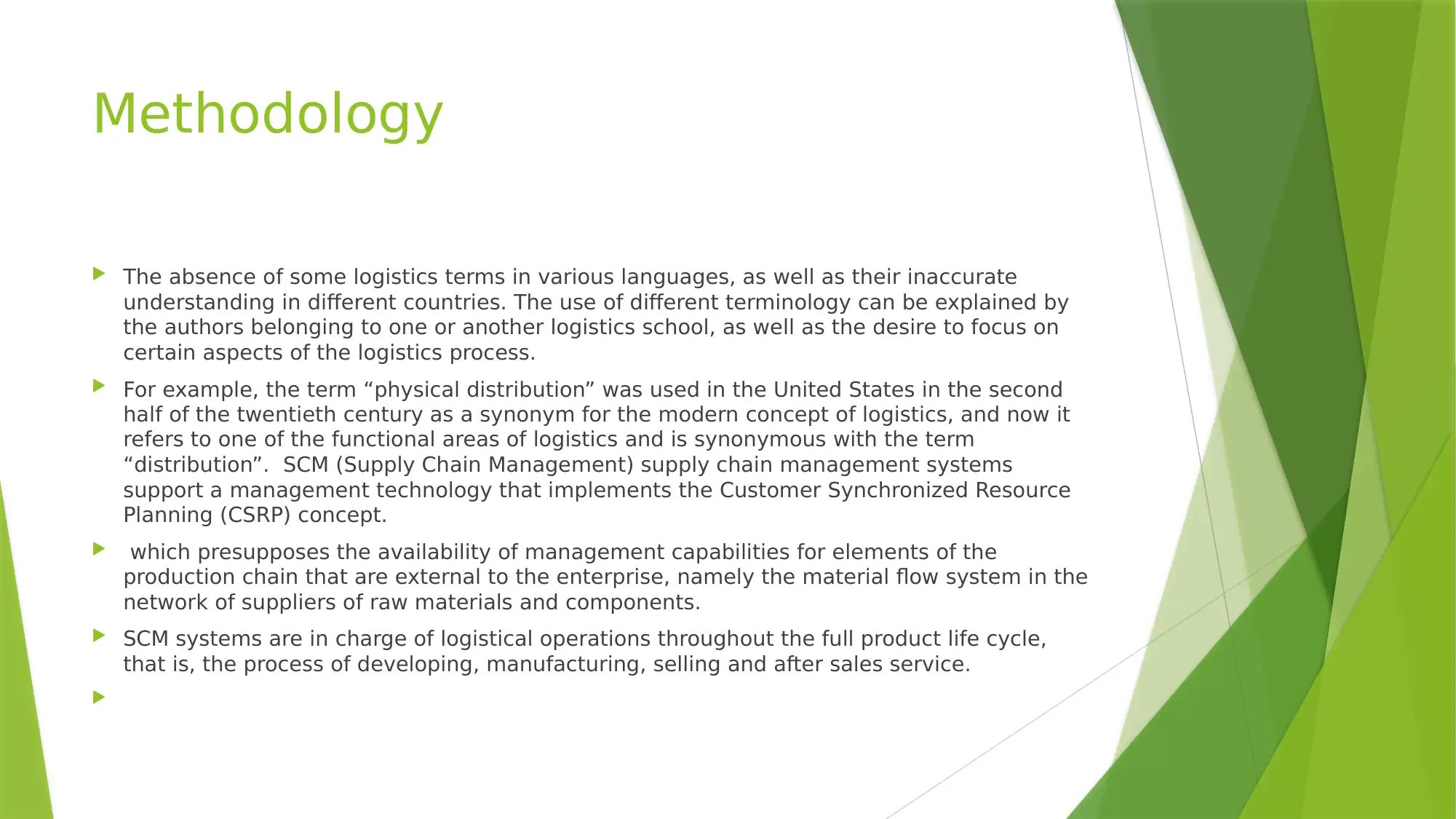
Methodology
The absence of some logistics terms in various languages, as well as their inaccurate
understanding in different countries. The use of different terminology can be explained by
the authors belonging to one or another logistics school, as well as the desire to focus on
certain aspects of the logistics process.
For example, the term “physical distribution” was used in the United States in the second
half of the twentieth century as a synonym for the modern concept of logistics, and now it
refers to one of the functional areas of logistics and is synonymous with the term
“distribution”. SCM (Supply Chain Management) supply chain management systems
support a management technology that implements the Customer Synchronized Resource
Planning (CSRP) concept.
which presupposes the availability of management capabilities for elements of the
production chain that are external to the enterprise, namely the material flow system in the
network of suppliers of raw materials and components.
SCM systems are in charge of logistical operations throughout the full product life cycle,
that is, the process of developing, manufacturing, selling and after sales service.
The absence of some logistics terms in various languages, as well as their inaccurate
understanding in different countries. The use of different terminology can be explained by
the authors belonging to one or another logistics school, as well as the desire to focus on
certain aspects of the logistics process.
For example, the term “physical distribution” was used in the United States in the second
half of the twentieth century as a synonym for the modern concept of logistics, and now it
refers to one of the functional areas of logistics and is synonymous with the term
“distribution”. SCM (Supply Chain Management) supply chain management systems
support a management technology that implements the Customer Synchronized Resource
Planning (CSRP) concept.
which presupposes the availability of management capabilities for elements of the
production chain that are external to the enterprise, namely the material flow system in the
network of suppliers of raw materials and components.
SCM systems are in charge of logistical operations throughout the full product life cycle,
that is, the process of developing, manufacturing, selling and after sales service.
⊘ This is a preview!⊘
Do you want full access?
Subscribe today to unlock all pages.

Trusted by 1+ million students worldwide
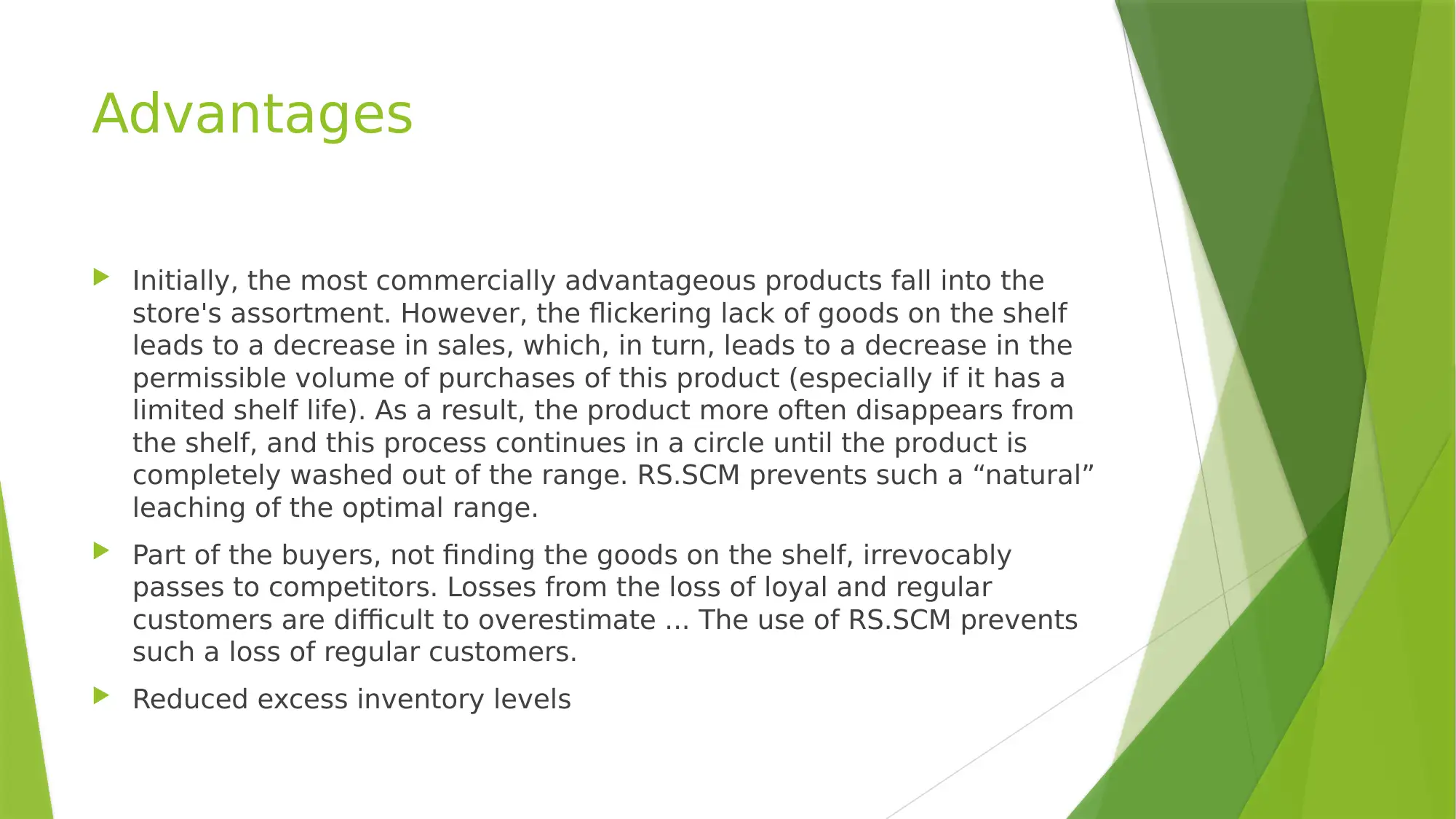
Advantages
Initially, the most commercially advantageous products fall into the
store's assortment. However, the flickering lack of goods on the shelf
leads to a decrease in sales, which, in turn, leads to a decrease in the
permissible volume of purchases of this product (especially if it has a
limited shelf life). As a result, the product more often disappears from
the shelf, and this process continues in a circle until the product is
completely washed out of the range. RS.SCM prevents such a “natural”
leaching of the optimal range.
Part of the buyers, not finding the goods on the shelf, irrevocably
passes to competitors. Losses from the loss of loyal and regular
customers are difficult to overestimate ... The use of RS.SCM prevents
such a loss of regular customers.
Reduced excess inventory levels
Initially, the most commercially advantageous products fall into the
store's assortment. However, the flickering lack of goods on the shelf
leads to a decrease in sales, which, in turn, leads to a decrease in the
permissible volume of purchases of this product (especially if it has a
limited shelf life). As a result, the product more often disappears from
the shelf, and this process continues in a circle until the product is
completely washed out of the range. RS.SCM prevents such a “natural”
leaching of the optimal range.
Part of the buyers, not finding the goods on the shelf, irrevocably
passes to competitors. Losses from the loss of loyal and regular
customers are difficult to overestimate ... The use of RS.SCM prevents
such a loss of regular customers.
Reduced excess inventory levels
Paraphrase This Document
Need a fresh take? Get an instant paraphrase of this document with our AI Paraphraser
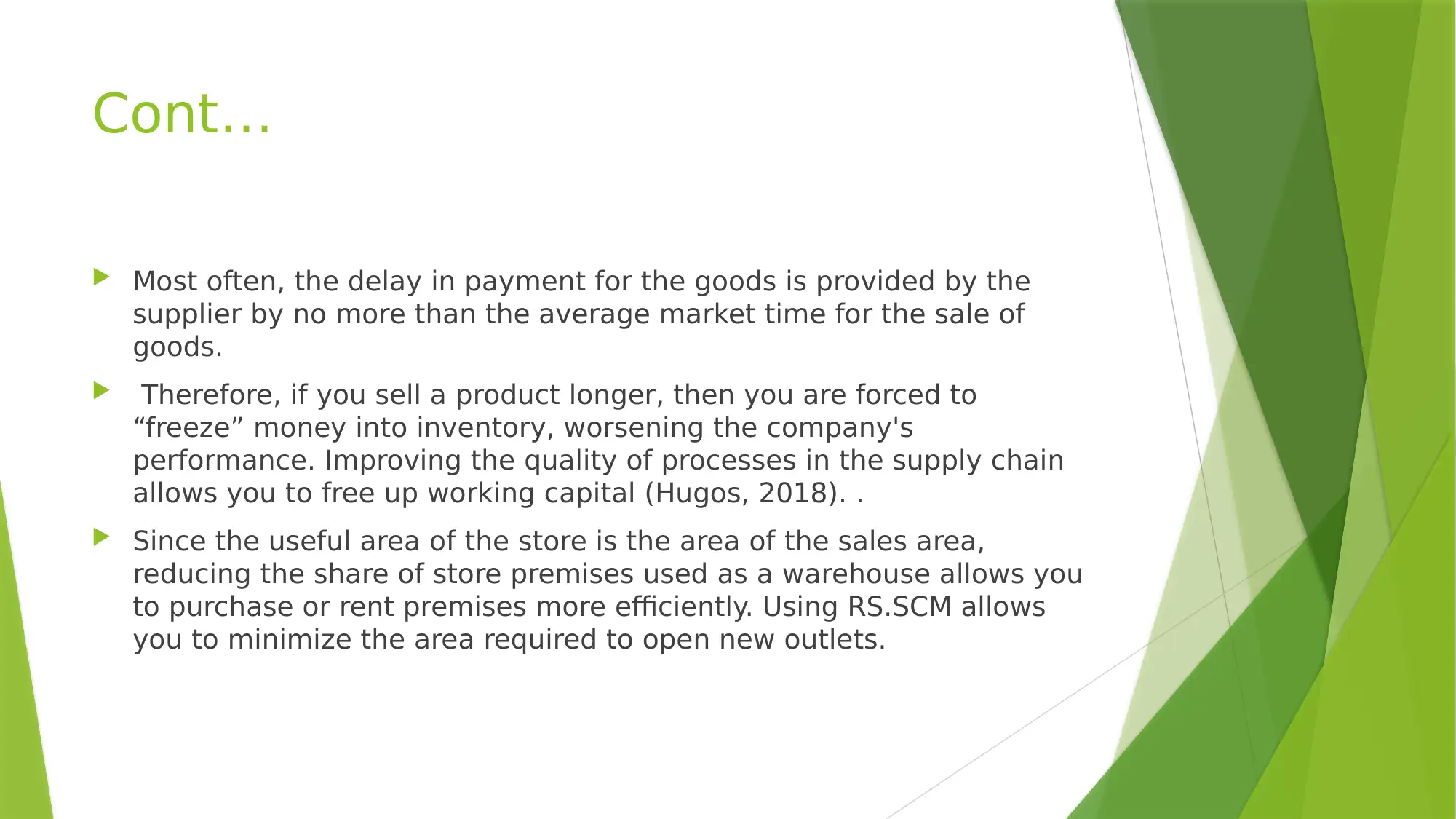
Cont…
Most often, the delay in payment for the goods is provided by the
supplier by no more than the average market time for the sale of
goods.
Therefore, if you sell a product longer, then you are forced to
“freeze” money into inventory, worsening the company's
performance. Improving the quality of processes in the supply chain
allows you to free up working capital (Hugos, 2018). .
Since the useful area of the store is the area of the sales area,
reducing the share of store premises used as a warehouse allows you
to purchase or rent premises more efficiently. Using RS.SCM allows
you to minimize the area required to open new outlets.
Most often, the delay in payment for the goods is provided by the
supplier by no more than the average market time for the sale of
goods.
Therefore, if you sell a product longer, then you are forced to
“freeze” money into inventory, worsening the company's
performance. Improving the quality of processes in the supply chain
allows you to free up working capital (Hugos, 2018). .
Since the useful area of the store is the area of the sales area,
reducing the share of store premises used as a warehouse allows you
to purchase or rent premises more efficiently. Using RS.SCM allows
you to minimize the area required to open new outlets.
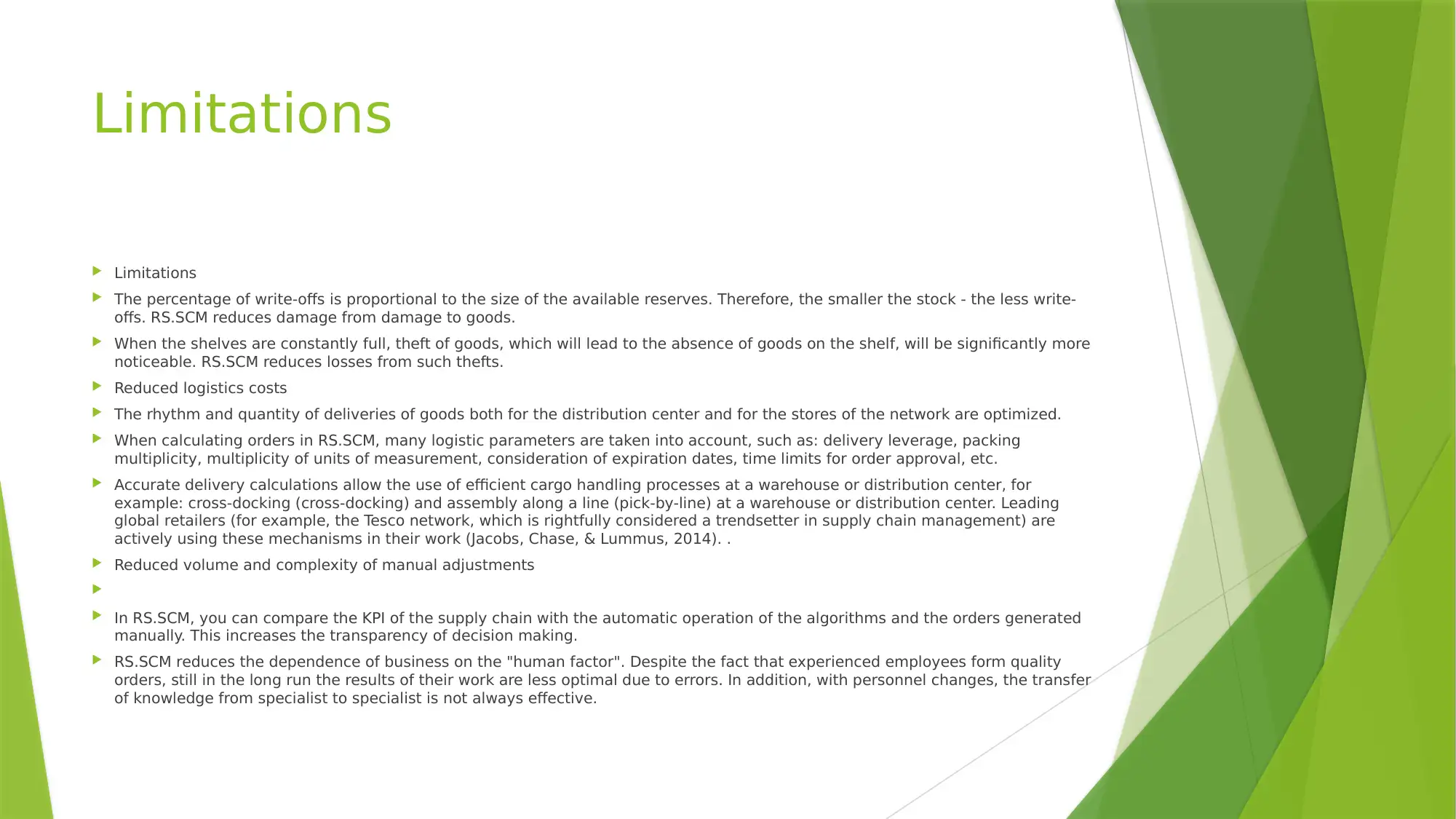
Limitations
Limitations
The percentage of write-offs is proportional to the size of the available reserves. Therefore, the smaller the stock - the less write-
offs. RS.SCM reduces damage from damage to goods.
When the shelves are constantly full, theft of goods, which will lead to the absence of goods on the shelf, will be significantly more
noticeable. RS.SCM reduces losses from such thefts.
Reduced logistics costs
The rhythm and quantity of deliveries of goods both for the distribution center and for the stores of the network are optimized.
When calculating orders in RS.SCM, many logistic parameters are taken into account, such as: delivery leverage, packing
multiplicity, multiplicity of units of measurement, consideration of expiration dates, time limits for order approval, etc.
Accurate delivery calculations allow the use of efficient cargo handling processes at a warehouse or distribution center, for
example: cross-docking (cross-docking) and assembly along a line (pick-by-line) at a warehouse or distribution center. Leading
global retailers (for example, the Tesco network, which is rightfully considered a trendsetter in supply chain management) are
actively using these mechanisms in their work (Jacobs, Chase, & Lummus, 2014). .
Reduced volume and complexity of manual adjustments
In RS.SCM, you can compare the KPI of the supply chain with the automatic operation of the algorithms and the orders generated
manually. This increases the transparency of decision making.
RS.SCM reduces the dependence of business on the "human factor". Despite the fact that experienced employees form quality
orders, still in the long run the results of their work are less optimal due to errors. In addition, with personnel changes, the transfer
of knowledge from specialist to specialist is not always effective.
Limitations
The percentage of write-offs is proportional to the size of the available reserves. Therefore, the smaller the stock - the less write-
offs. RS.SCM reduces damage from damage to goods.
When the shelves are constantly full, theft of goods, which will lead to the absence of goods on the shelf, will be significantly more
noticeable. RS.SCM reduces losses from such thefts.
Reduced logistics costs
The rhythm and quantity of deliveries of goods both for the distribution center and for the stores of the network are optimized.
When calculating orders in RS.SCM, many logistic parameters are taken into account, such as: delivery leverage, packing
multiplicity, multiplicity of units of measurement, consideration of expiration dates, time limits for order approval, etc.
Accurate delivery calculations allow the use of efficient cargo handling processes at a warehouse or distribution center, for
example: cross-docking (cross-docking) and assembly along a line (pick-by-line) at a warehouse or distribution center. Leading
global retailers (for example, the Tesco network, which is rightfully considered a trendsetter in supply chain management) are
actively using these mechanisms in their work (Jacobs, Chase, & Lummus, 2014). .
Reduced volume and complexity of manual adjustments
In RS.SCM, you can compare the KPI of the supply chain with the automatic operation of the algorithms and the orders generated
manually. This increases the transparency of decision making.
RS.SCM reduces the dependence of business on the "human factor". Despite the fact that experienced employees form quality
orders, still in the long run the results of their work are less optimal due to errors. In addition, with personnel changes, the transfer
of knowledge from specialist to specialist is not always effective.
⊘ This is a preview!⊘
Do you want full access?
Subscribe today to unlock all pages.

Trusted by 1+ million students worldwide
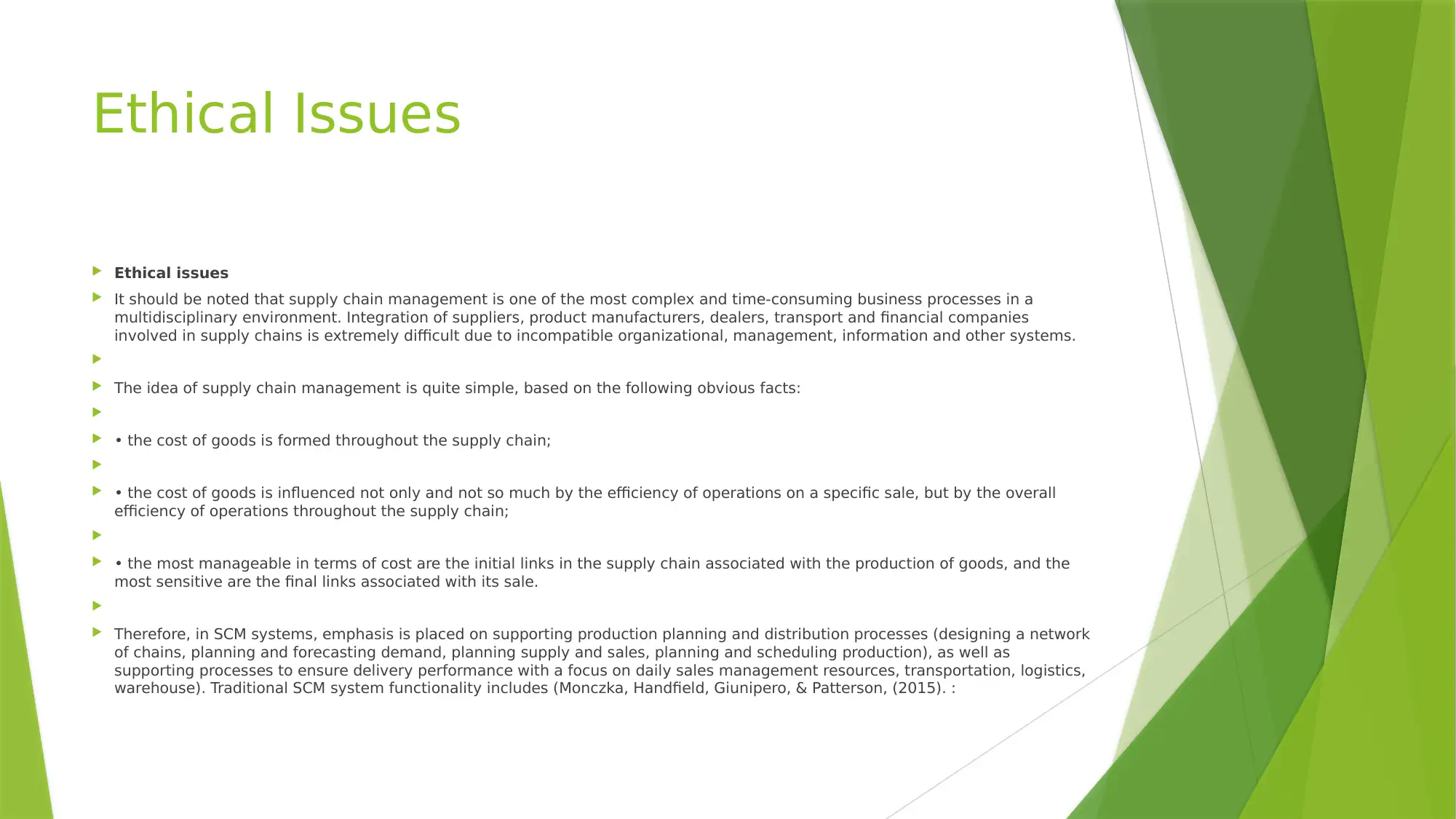
Ethical Issues
Ethical issues
It should be noted that supply chain management is one of the most complex and time-consuming business processes in a
multidisciplinary environment. Integration of suppliers, product manufacturers, dealers, transport and financial companies
involved in supply chains is extremely difficult due to incompatible organizational, management, information and other systems.
The idea of supply chain management is quite simple, based on the following obvious facts:
• the cost of goods is formed throughout the supply chain;
• the cost of goods is influenced not only and not so much by the efficiency of operations on a specific sale, but by the overall
efficiency of operations throughout the supply chain;
• the most manageable in terms of cost are the initial links in the supply chain associated with the production of goods, and the
most sensitive are the final links associated with its sale.
Therefore, in SCM systems, emphasis is placed on supporting production planning and distribution processes (designing a network
of chains, planning and forecasting demand, planning supply and sales, planning and scheduling production), as well as
supporting processes to ensure delivery performance with a focus on daily sales management resources, transportation, logistics,
warehouse). Traditional SCM system functionality includes (Monczka, Handfield, Giunipero, & Patterson, (2015). :
Ethical issues
It should be noted that supply chain management is one of the most complex and time-consuming business processes in a
multidisciplinary environment. Integration of suppliers, product manufacturers, dealers, transport and financial companies
involved in supply chains is extremely difficult due to incompatible organizational, management, information and other systems.
The idea of supply chain management is quite simple, based on the following obvious facts:
• the cost of goods is formed throughout the supply chain;
• the cost of goods is influenced not only and not so much by the efficiency of operations on a specific sale, but by the overall
efficiency of operations throughout the supply chain;
• the most manageable in terms of cost are the initial links in the supply chain associated with the production of goods, and the
most sensitive are the final links associated with its sale.
Therefore, in SCM systems, emphasis is placed on supporting production planning and distribution processes (designing a network
of chains, planning and forecasting demand, planning supply and sales, planning and scheduling production), as well as
supporting processes to ensure delivery performance with a focus on daily sales management resources, transportation, logistics,
warehouse). Traditional SCM system functionality includes (Monczka, Handfield, Giunipero, & Patterson, (2015). :
Paraphrase This Document
Need a fresh take? Get an instant paraphrase of this document with our AI Paraphraser
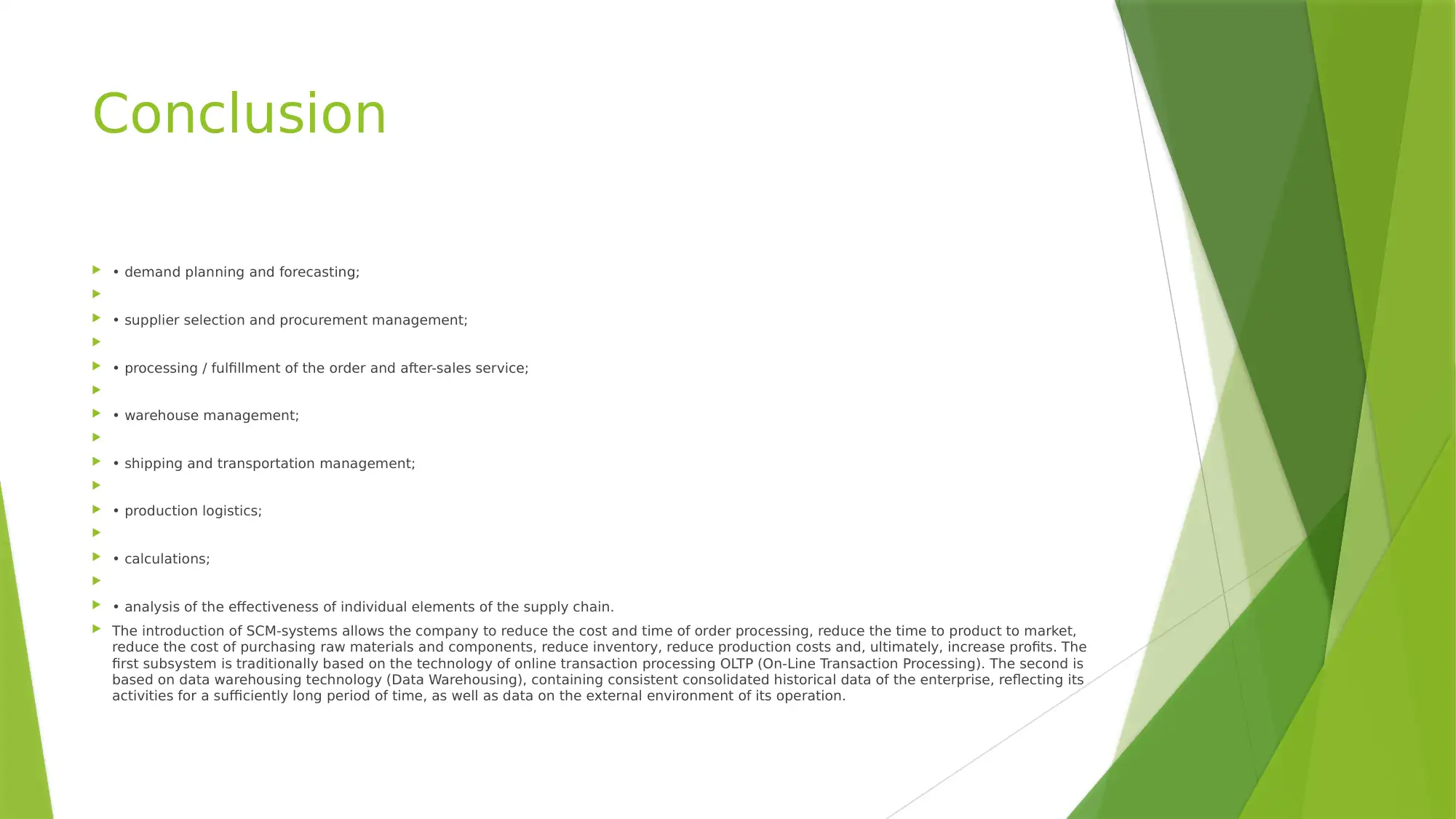
Conclusion
• demand planning and forecasting;
• supplier selection and procurement management;
• processing / fulfillment of the order and after-sales service;
• warehouse management;
• shipping and transportation management;
• production logistics;
• calculations;
• analysis of the effectiveness of individual elements of the supply chain.
The introduction of SCM-systems allows the company to reduce the cost and time of order processing, reduce the time to product to market,
reduce the cost of purchasing raw materials and components, reduce inventory, reduce production costs and, ultimately, increase profits. The
first subsystem is traditionally based on the technology of online transaction processing OLTP (On-Line Transaction Processing). The second is
based on data warehousing technology (Data Warehousing), containing consistent consolidated historical data of the enterprise, reflecting its
activities for a sufficiently long period of time, as well as data on the external environment of its operation.
• demand planning and forecasting;
• supplier selection and procurement management;
• processing / fulfillment of the order and after-sales service;
• warehouse management;
• shipping and transportation management;
• production logistics;
• calculations;
• analysis of the effectiveness of individual elements of the supply chain.
The introduction of SCM-systems allows the company to reduce the cost and time of order processing, reduce the time to product to market,
reduce the cost of purchasing raw materials and components, reduce inventory, reduce production costs and, ultimately, increase profits. The
first subsystem is traditionally based on the technology of online transaction processing OLTP (On-Line Transaction Processing). The second is
based on data warehousing technology (Data Warehousing), containing consistent consolidated historical data of the enterprise, reflecting its
activities for a sufficiently long period of time, as well as data on the external environment of its operation.
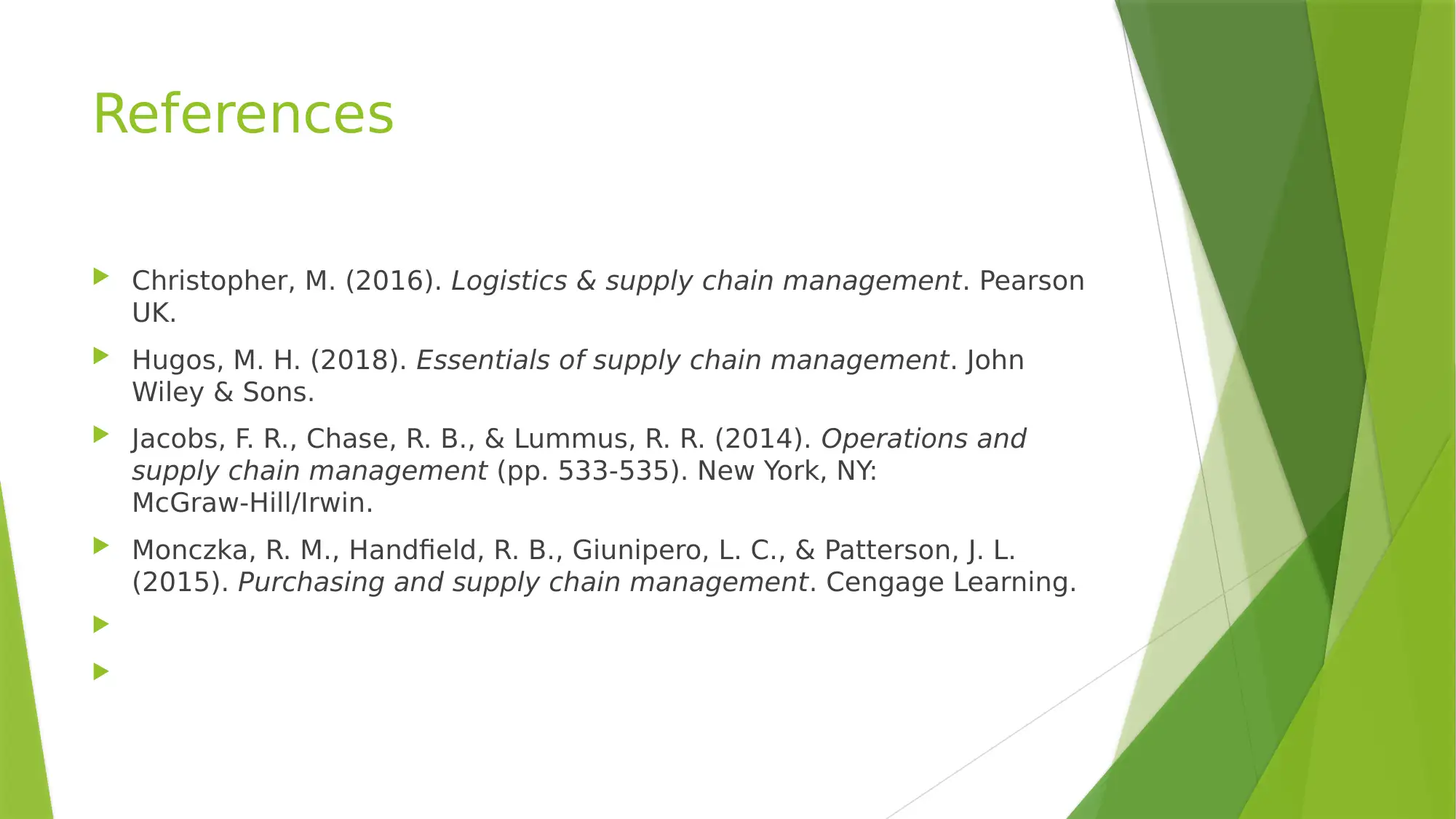
References
Christopher, M. (2016). Logistics & supply chain management. Pearson
UK.
Hugos, M. H. (2018). Essentials of supply chain management. John
Wiley & Sons.
Jacobs, F. R., Chase, R. B., & Lummus, R. R. (2014). Operations and
supply chain management (pp. 533-535). New York, NY:
McGraw-Hill/Irwin.
Monczka, R. M., Handfield, R. B., Giunipero, L. C., & Patterson, J. L.
(2015). Purchasing and supply chain management. Cengage Learning.
Christopher, M. (2016). Logistics & supply chain management. Pearson
UK.
Hugos, M. H. (2018). Essentials of supply chain management. John
Wiley & Sons.
Jacobs, F. R., Chase, R. B., & Lummus, R. R. (2014). Operations and
supply chain management (pp. 533-535). New York, NY:
McGraw-Hill/Irwin.
Monczka, R. M., Handfield, R. B., Giunipero, L. C., & Patterson, J. L.
(2015). Purchasing and supply chain management. Cengage Learning.
⊘ This is a preview!⊘
Do you want full access?
Subscribe today to unlock all pages.

Trusted by 1+ million students worldwide
1 out of 9
Your All-in-One AI-Powered Toolkit for Academic Success.
+13062052269
info@desklib.com
Available 24*7 on WhatsApp / Email
![[object Object]](/_next/static/media/star-bottom.7253800d.svg)
Unlock your academic potential
Copyright © 2020–2025 A2Z Services. All Rights Reserved. Developed and managed by ZUCOL.

